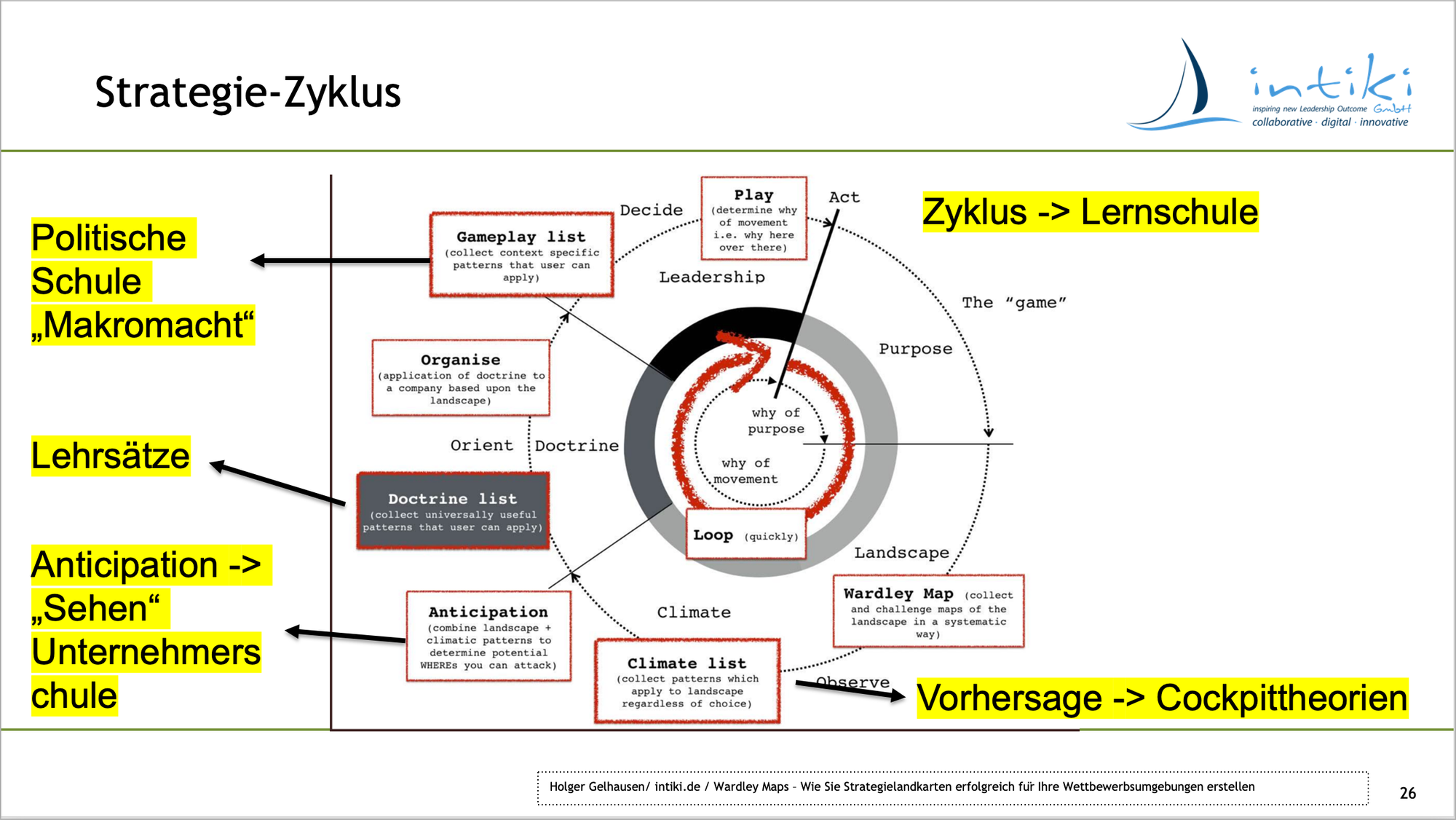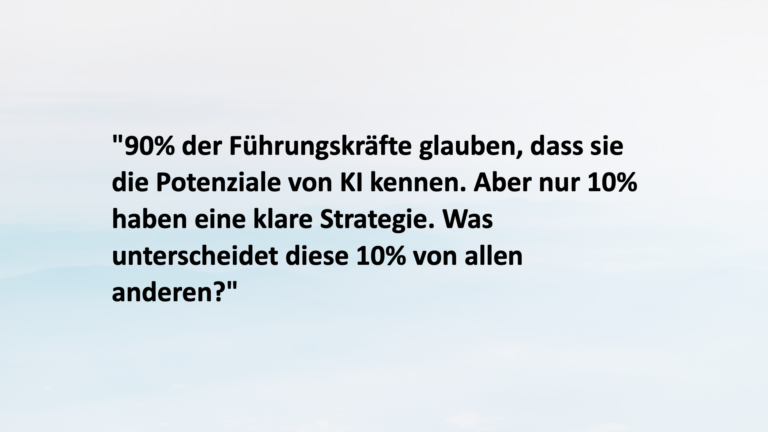#103 Simon Wardleys Keynote auf dem KI-Insights Event
Worum geht es in diesem Artikel?
Die Keynote von Simon Wardley Vortrag auf dem KI-Insights Event am 15.03.2023. Der Blogpost enthält eine Summary, das Video und einen längeren Blogpost über den Vortrag
Simon Wardley hat mit den WardleyMaps eine neue Strategie Sprache entwickelt, die auf einer Seite einen Strategiezyklus abbildet. Wardley Maps vereinen viele Strategie Ansätze.

Der Blog Post hat vier Abschnitte:
- Ich möchte mehr über WardleyMaps wissen
- Words of Wisdom – eine kurze Zusammenfassung des Vortrages
- Das Youtube Video des Vortrages
- Ein Blogpost auf Basis der Transcription von Simons Vortrag
Ich möchte mehr über WardleyMaps wissen
In dieser Meetup Gruppe werden wir weiter Meetups zu Themen rund um Strategie durchführen.
Für alle die tiefer einsteigen möchten, hier besprechen wir am 10.04 um 14 Uhr die Keynote von Simon Wardley
Words of Wisdom – eine kurze Zusammenfassung
Der Vortragende diskutiert Muster des technologischen Wandels, Investitionsstrategien und den Einfluss der Cloud-Technologie.
IDEAS:
- Inertia in Unternehmen entsteht durch frühere Geschäftsmodelle.
- Red Queen-Effekt erzeugt Adaptionsdruck im Wettbewerb.
- Jevons Paradox erklärt, warum IT-Kosten nicht sinken.
- Cloud-Technologie erhöht IT-Personalbedarf statt ihn zu reduzieren.
- Serverless Computing folgt bekannten Innovationsmustern.
- Strategien in der Technologiebranche sind iterativ und transitiv.
- FinOps entwickelt sich als neuer Praxisansatz in IT-Finanzen.
- Innovate-Leverage-Commoditize-Modell fördert Ökosystemwachstum.
- Ermöglicht Erkennen von Mustern durch Analyse von Metadaten.
- Ecosystemsgröße verbessert Innovationstempo und Kundennähe.
- Unternehmen nutzen Cloud-Geschäftsmodelle zur Marktdominanz.
- Maschinelles Lernen baut auf Cloud-Ökosystemen auf.
- Routinetätigkeiten von Fachkräften könnten durch KI ersetzt werden.
QUOTES:
- „Inertia created by preexisting business models hinders innovation.“
- „You have no choice over evolution in competitive markets.“
- „Cloud computing’s rise challenges traditional IT paradigms.“
- „Old practices create inertia that inhibits embracing new technologies.“
- „The Red Queen effect forces continuous adaptation or obsolescence.“
- „Resource efficiency leads to doing more, not spending less.“
- „Playing the cloud game correctly requires understanding underlying patterns.“
- „Strategies must evolve as technology ecosystems and practices change.“
- „Innovate, leverage, commoditize accelerates growth and innovation rates.“
- „Understanding metadata enables anticipation of industry evolution.“
HABITS:
- Analyzing historical patterns to predict technology shifts.
- Investing in emerging practices and technologies early.
- Avoiding areas where inertia obstructs innovation.
- Adopting iterative strategies for market engagement.
- Leveraging cloud services to drive innovation.
- Mining metadata to identify growing industry segments.
- Scaling ecosystems to enhance innovation efficiency.
- Staying mindful of IT-budget reality versus speculation.
- Using mapping techniques for strategic investment decisions.
- Fostering ecosystem development for competitive advantage.
FACTS:
- Blockbuster was innovative but succumbed to business inertia.
- Cloud adoption has not necessarily reduced IT budgets.
- Energy consumption in IT has increased with cloud computing.
- Ubuntu’s cloud market share growth driven by strategic mapping.
- DevOps emergence was a response to the need for efficiency.
- Continuous adaptation in technology is critical for survival.
- IT departments grow to meet expanding service demands.
- Early adoption of cloud technologies led to market dominance.
- Innovate-Leverage-Commoditize model is a powerful growth tool.
- Intelligent machines may assume routine professional tasks by 2062.
REFERENZEN:
- Buch „The Silent Conquest“ von Donald Michaels.
- Konzept von Van Valen’s Red Queen effect.
- Jevons Paradox im Kontext der IT-Budgets.
- DevOps und FinOps als Branchenpraktiken.
- Innovate-Leverage-Commoditize (ILC) Modell.
- Buch „Reaching Cloud Velocity“ von AWS.
- Mark Shuttleworth und Canonical’s Investitionsstrategien.
- Mapping-Techniken für strategische Marktanalysen.
- Maschinelles Lernen als Aufbau auf Cloud-Basis.
- Cybernation’s Prognose über KI-Einsatz in der Zukunft.
EMPFEHLUNGEN:
- Beobachten Sie frühere Geschäftsmodelle auf Inertieeffekte.
- Adaptieren Sie sich an die Evolution im Technologiemarkt.
- Nutzen Sie Cloud-Dienste für datenbasierte Strategieanpassungen.
- Investieren Sie in effizienzorientierte IT-Praktiken wie DevOps.
- Vermeiden Sie Investitionen in durch Inertia blockierte Technologien.
- Bauen Sie auf ein Ökosystem, das Innovationsraten verbessert.
- Entwickeln Sie Strategien weiter, um mit dem Markt Schritt zu halten.
- Verstehen Sie Metadatenanalyse als Werkzeug zur Mustererkennung.
- Beachten Sie Jevons Paradox bei IT-Budgetplanungen.
- Seien Sie auf die mögliche Automatisierung durch KI vorbereitet.
Das Youtube Video des Vortrages
00-00 Simon Wardleys Keynote auf dem KI-Insights Event Nr. 3
In 2005, Wardley Mapping was conceived as a tool for gaining strategic insights and understanding the changing landscapes within industries. Its creator embarked on this journey following a personal realisation of inadequacies in strategic planning while running an online photo service. This approach to strategy, shaped by ancient wisdom from Sun Tzu’s discussions on competition and principles of warfare, along with John Boyd’s OODA loop, offers a framework to navigate the complexities of business and competition.
Wardley Mapping draws parallels between military strategies and business decisions, emphasising the importance of understanding one’s environment and adapting principles accordingly to maintain an edge. The technique has evolved to aid in comprehending the dynamics of change and identifying patterns that impact decision-making processes. Insights from historical battles, such as the Battle of Thermopylae, have influenced its development, demonstrating its unique perspective on strategic thinking and its potential application in various contexts, including the realm of artificial intelligence.
Key Takeaways
- Wardley Mapping emerged as a strategic tool for business analysis and landscape understanding.
- It integrates principles derived from military strategy and competitive analysis.
- The methodology facilitates strategic decision-making, particularly in dynamic sectors like AI.
Genesis of Wardley Mapping
Wardley Mapping emerged in 2005 from the need to navigate the complexities of business strategy. It represents an innovative approach to understanding organisational landscapes, strategic planning, and the forces that shape competitive environments. The conception of this technique was a consequence of personal experience and a thirst for strategic comprehension that was not being quenched by the contemporary business tools.
While managing a profitable online photo service company, the creator of Wardley Mapping, who also served as its CEO, faced a pressing challenge. Despite the organisation’s success, there was an underlying problem with decision-making and strategic direction, which was especially problematic as the CEO himself was flying blind in terms of strategy.
The initial spark of inspiration came from the ancient wisdom of Sun Tzu, whose writings on competition and the five factors influencing it highlighted the importance of understanding one’s landscape and environment—the climate, as well as having clear guiding principles and effective leadership.
Key Inspirations:
- Sun Tzu’s The Art of War: The recognition of five crucial factors in competition, namely purpose, understanding of the landscape, climate, doctrine, and leadership.
- John Boyd and the OODA loop (Observe, Orient, Decide, Act): A concept deeply intertwined with grasping the environment and the situational dynamics to make informed strategic choices.
Fascinated by the military history and application of strategic maps, such as those employed in the historic Battle of Thermopylae, the author recognised the value of spatial awareness in assessing and conveying strategic movements. In contrast, traditional business tools such as SWOT diagrams and financial statements appeared inadequate for effective communication and strategic alignment within an organisation.
The Problem of Alignment:
- Traditional business artefacts (SWOT diagrams, balance sheets) versus strategic maps: A lack of a common language and framework was causing misalignment in business strategy and operations.
The practice of mapping, as it pertains to business environments, provides a shared language and a coherent visualisation of the competitive landscape. It enables an organisation to comprehend and manipulate the terrain to its advantage. The advent of Wardley Mapping offered a much-needed holistic viewpoint for understanding and communicating strategy, establishing a common frame of reference across all levels of the organisation.
This new methodology focused on the five imperative factors mentioned, aligning them with the process of constant evaluation and reorientation, akin to the OODA loop. Applying this approach to the contemporary field of Artificial Intelligence, he expounded on the transformative potential of a cohesive and comprehensive mapping technique for strategic investment and change management within the fast-evolving AI sector.
Trends in Cartographic Analysis
In the exploration of strategic landscapes, the identification of recurring motifs has been a pivotal aspect in understanding competition. The process encapsulates various forms of interaction among entities including combat, collaboration, and assistance, all of which serve the purpose of securing a particular goal or resource.
To effectively navigate the complexities of competitive environments, it’s essential to consider:
- Purpose: One’s ethical driver behind actions
- Landscape: The domain where one operates
- Climate: The dynamic factors affecting the landscape
- Doctrine: The guiding principles informing the organisation’s conduct
- Leadership: Tactics executed to secure a competitive advantage
These elements interlink to provide a comprehensive approach to competition, with the landscape and its evolutionary patterns prominently featured.
The origins of strategic mapping lie in 2005, with the innovation of Wardley Mapping, aimed at addressing the lack of strategic direction within organisations. The tool offers insights into not only the present operative landscape but also forecasts potential shifts, thereby aiding in constructing resilient strategies.
Historical battles, such as the Battle of Thermopylae, are seminal in illustrating the potency of physical and conceptual mappings in conveying strategies effectively. They demonstrate the necessity of comprehending manoeuvres within a defined space rather than relying on abstract representations which may fail to capture the nuances of positional strategy.
The discrepancy between the use of divergent communicative tools—such as financial reports at the upper echelons and operational charts at lower levels—highlights the need for a unified approach to circumvent alignment issues within an organisation. The confluence of these lessons culminated in the conception of a mapping tool, designed not only to depict positions but to guide movements within a constantly evolving space, underscored by the need for congruity across all levels of an organisation.
Examining Change Through Cartography
In 2005, he developed a system known as Wardley Mapping, a strategic method to visualise and determine the actions within an evolving business landscape. His journey into mapping was a self-reflective one, coming from a time when, as CEO of an online photo service, he grappled with strategy planning. His strategy narratives were borrowed from other companies and lacked original insight.
Upon discovering ‚The Art of War‘ by Sun Tzu and exploring the five factors that matter in competition – purpose, landscape, climate, doctrine, and leadership – he found clarity. The fusion of these elements provided a perspective on how organisations might navigate and exploit change. The concepts resonated with John Boyd’s OODA loop that starts with observation of the landscape and climate, orientation through principles, and subsequent decisions and actions.
He then looked to historical battles such as Thermopylae to understand strategic positioning and communication. In contrast, the plethora of business tools available, such as SWOT analyses and Gantt charts, seemed discordant and fragmented within his company. The eureka moment came when he compared a map of the Battle of Thermopylae with a SWOT analysis, recognising the inherent power of mapping for clear communication of both position and movement.
Wardley emphasised the importance of common language for organisational alignment and effective strategy development through mapping. As a practical tool to scrutinise change, Wardley Maps integrate understanding of the environment with strategic foresight, especially pertinent in fast-evolving domains like artificial intelligence. Through this method, investments and actions can be more tactically planned and executed, streamlining the process of business adaptation and innovation.
Gameplay with Maps
Strategic Cartography in Action
In 2005, a novel approach to strategic analysis and environmental manipulation was pioneered, known today as Wardley Mapping. This technique provides an insightful perspective, especially notable within the realm of artificial intelligence.
When discussing strategic influence, it is essential to examine several key elements, including one’s purpose, the dynamic environment or landscape, current principles, and, importantly, the application of these within the context of gameplay to sway the environment to one’s advantage.
To effectively evaluate and strategise within a competitive landscape, one must adhere to the following:
- Purpose: A clear, ethical driver for actions and decisions.
- Landscape: A detailed awareness of the operational terrain.
- Climate: Insights into how this landscape evolves over time.
- Doctrine: A set of organisational principles, not hard rules.
- Leadership: The deft navigation of the landscape through strategic plays.
Historical Context and its Influence
The inception of this mapping method was inspired by classical military strategists and the examination of pivotal historical engagements, such as the Battle of Thermopylae. Such battles exemplify the crucial role of geography and strategic positioning in determining the outcomes of conflicts.
Reflecting on prior experiences as a CEO, the recognition of an unidentified strategy – borrowing vision statements and lacking true direction – laid the foundation for a transformation in strategic thinking. This led to the appreciation of common languages, like maps, to align an organisation’s strategy at all levels.
Practical Application in Business
Drawn from the annals of history, these insights were adapted to the corporate world, resulting in the creation of Wardley Maps. SWAT analyses, balance sheets, and other traditional business artefacts failed to embody the spatial aspect crucial for strategic coherence.
Wardley Mapping, therefore, stands out as a versatile and communicative tool, integrating purpose and landscape to orchestrate movements and gain a competitive advantage in any field, especially in the fast-moving tech industry centred around artificial intelligence.
Capital Allocation and Strategic Emphasis on Artificial Intelligence
He begins by reflecting on the conception of Wardley Mapping nearly two decades ago, a tool he developed to improve strategic business planning. This approach was born from his experiences as a CEO of an online photo service company, where despite profitability, there was a glaring issue with direction and strategy. He admits that in those days, strategy was a make-it-up-as-you-go endeavour, borrowing ideas from others without a solid framework.
During an incidental encounter with Sun Tzu’s „The Art of War“ at a London bookshop, he identifies five pivotal factors that influence competition, ranging from intention and moral imperative to understanding the changing landscape and organisational principles, finally culminating in tactical leadership. These discoveries parallel with John Boyd’s OODA loop, a strategy revolving around observation, orientation, decision, and action, which further anchored his interest in mapping.
Looking back to ancient history, he compares this method to the use of maps in military strategy, such as in the Battle of Thermopylae, stressing the importance of a shared language to navigate complex situations. In contrast to the disconnected tactical plans seen in organisations, which often lead to misalignment, maps serve as a crucial tool for conveying a unified vision.
With a particular focus on the burgeoning realm of artificial intelligence, he suggests leveraging these mapping strategies to decipher the evolving AI landscape. His aim is to utilise this methodology to steer investments in AI by harnessing a comprehensive understanding of the environment, thereby inspiring more informed decision-making to alter the competitive climate to one’s advantage.






